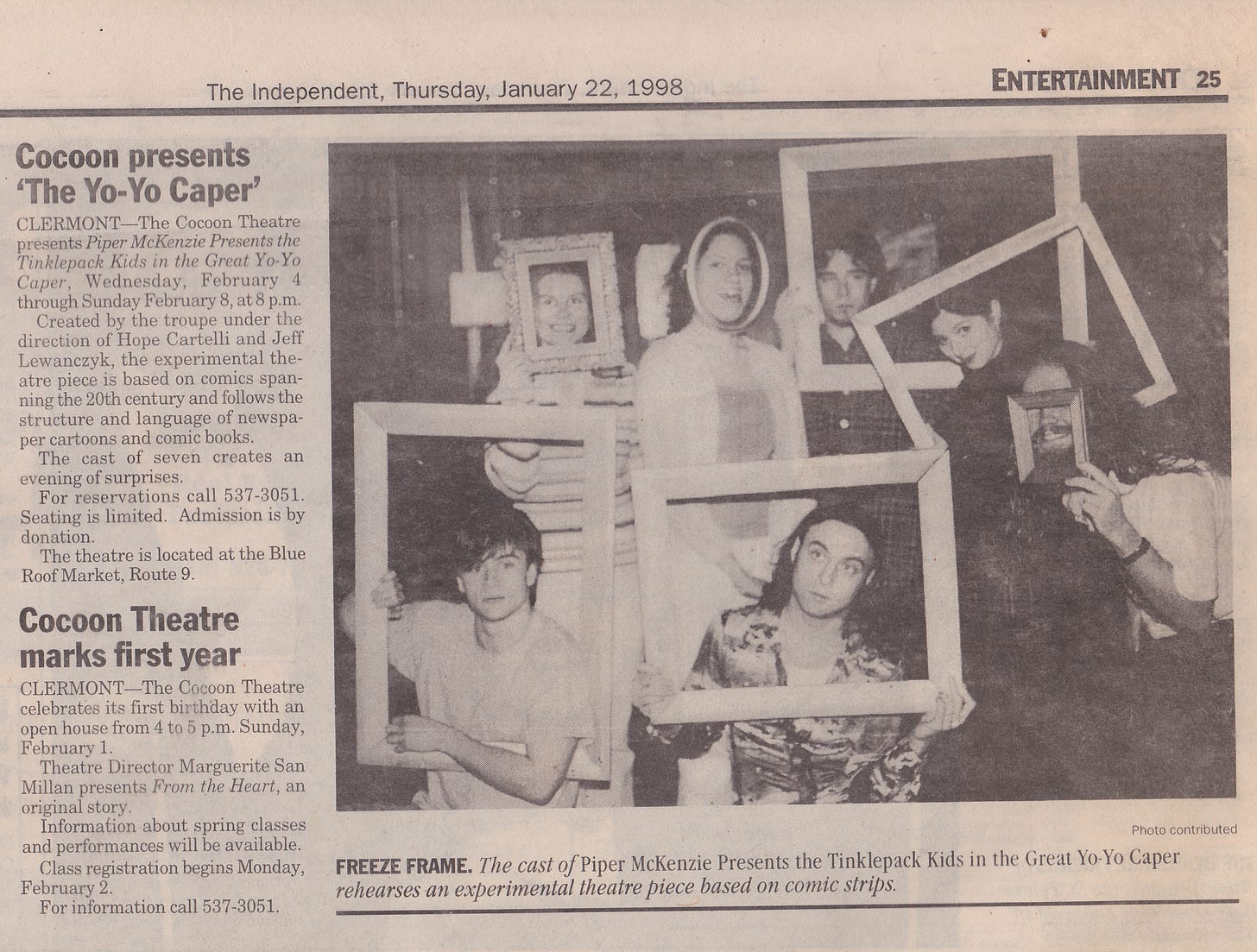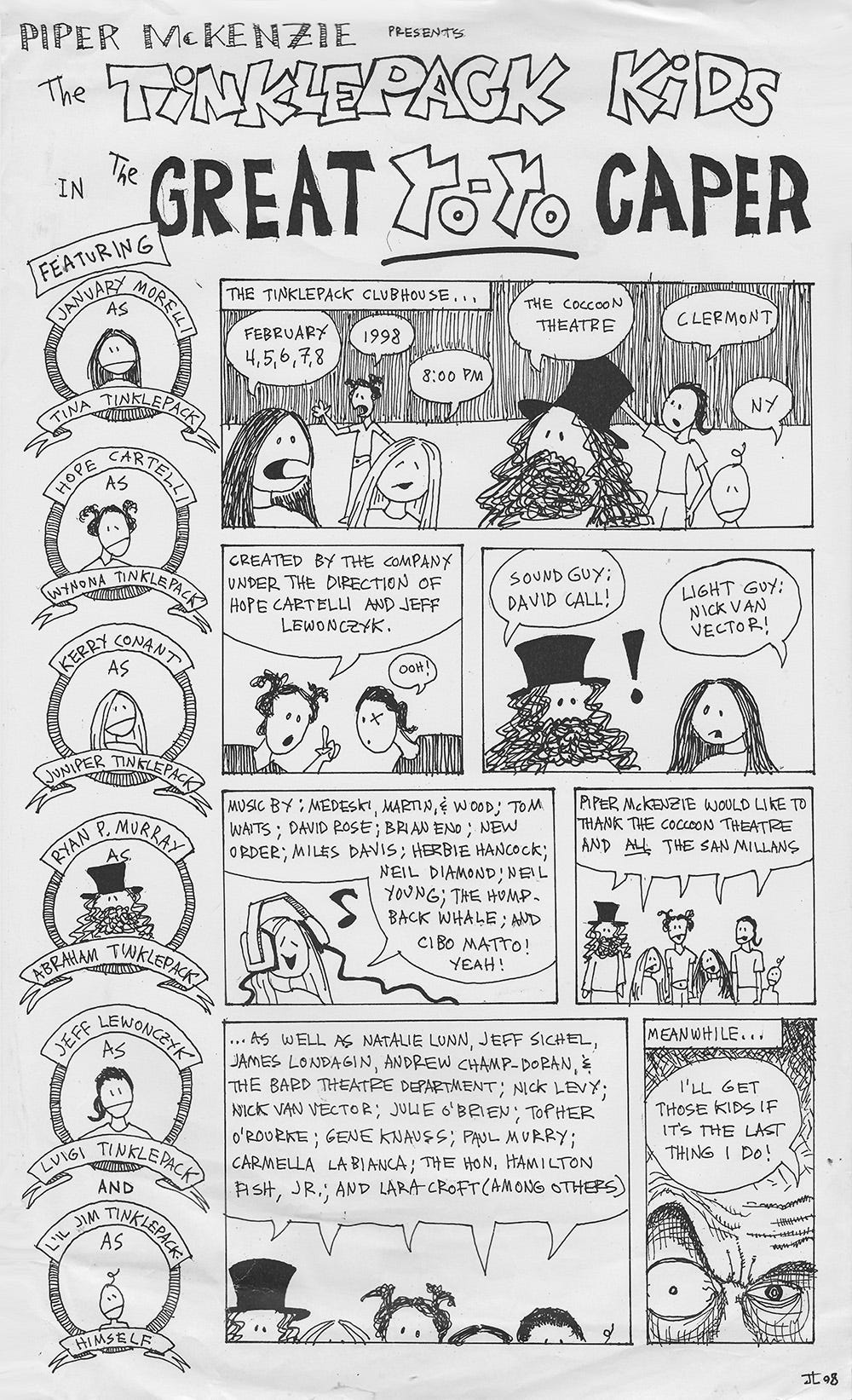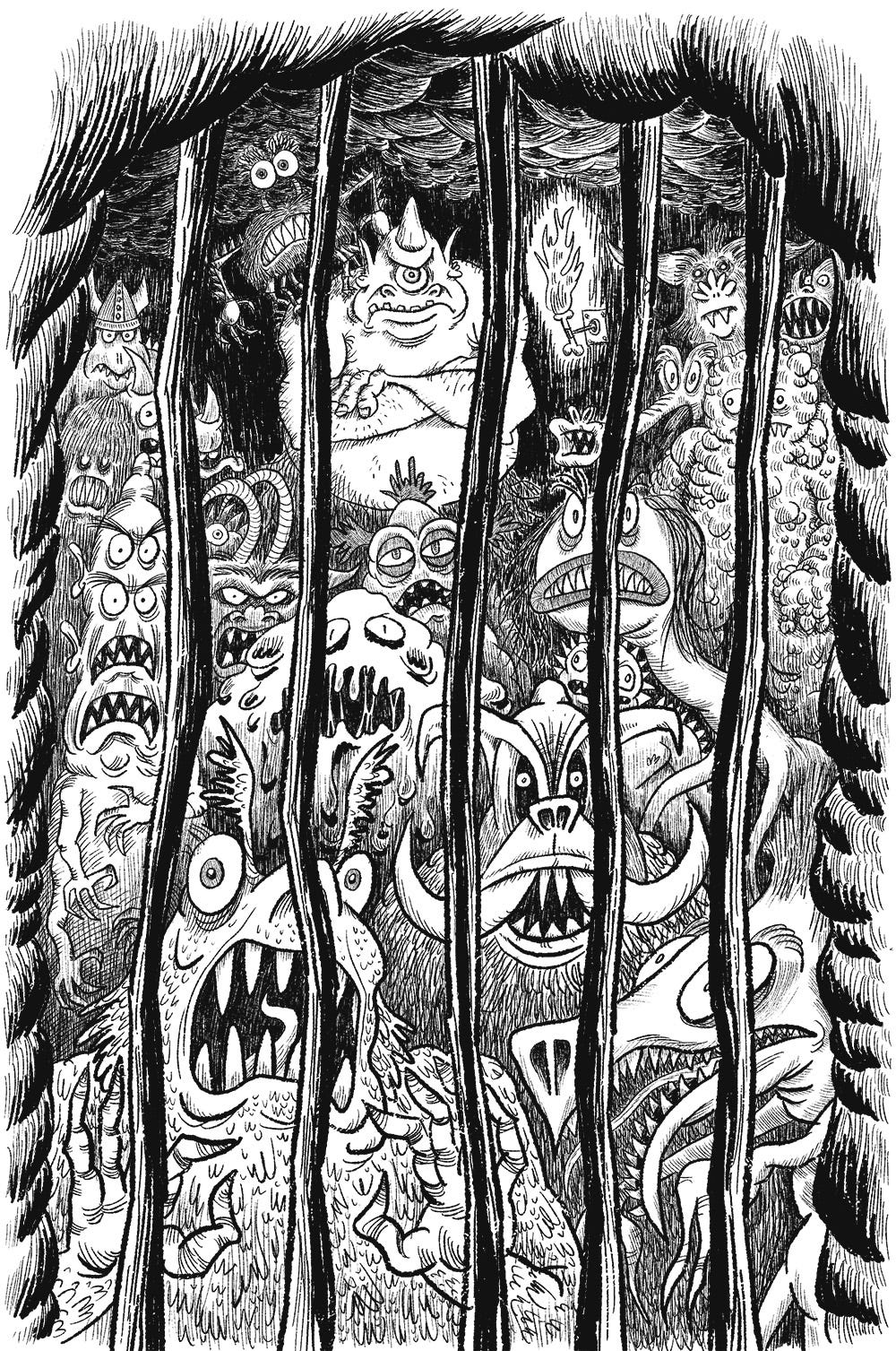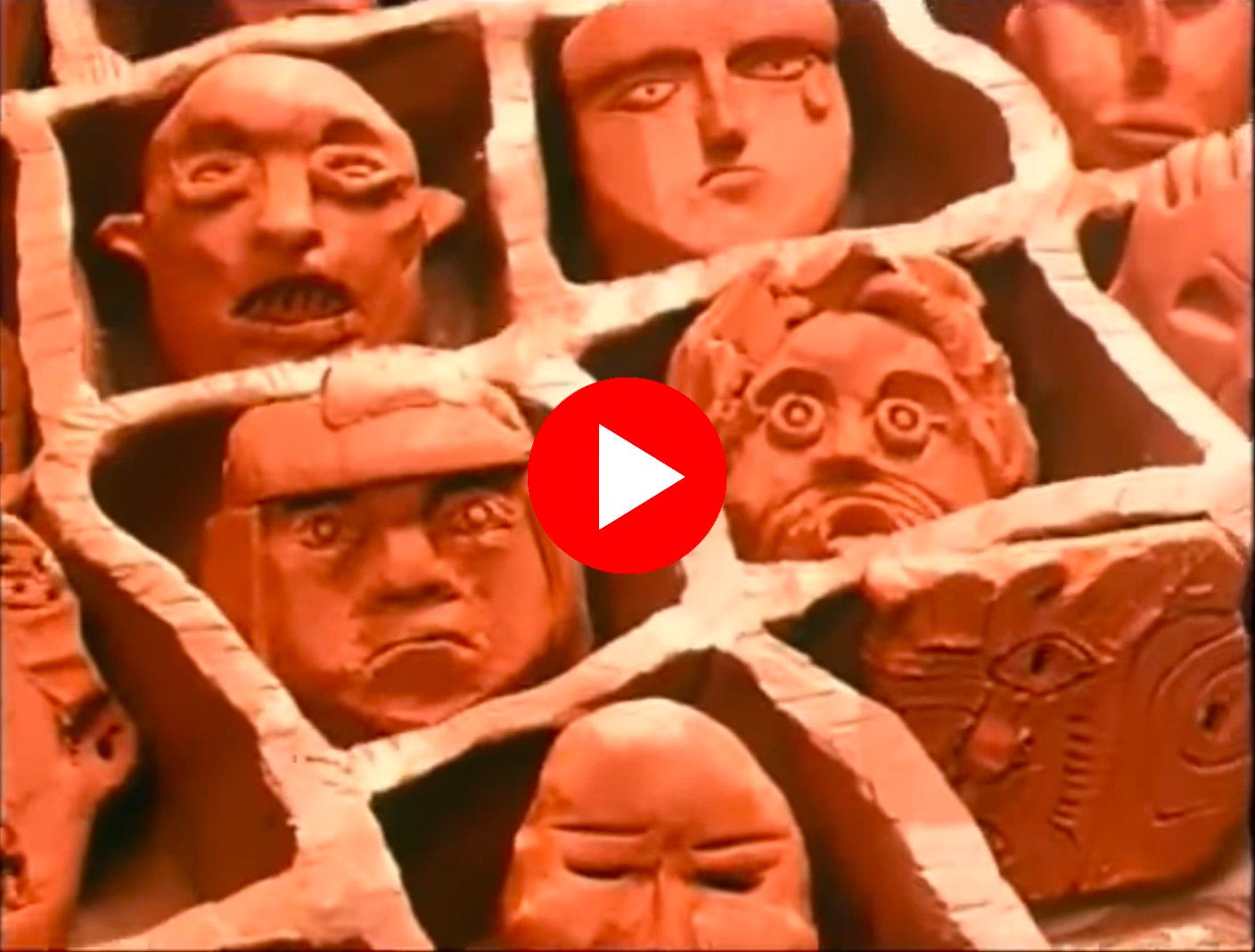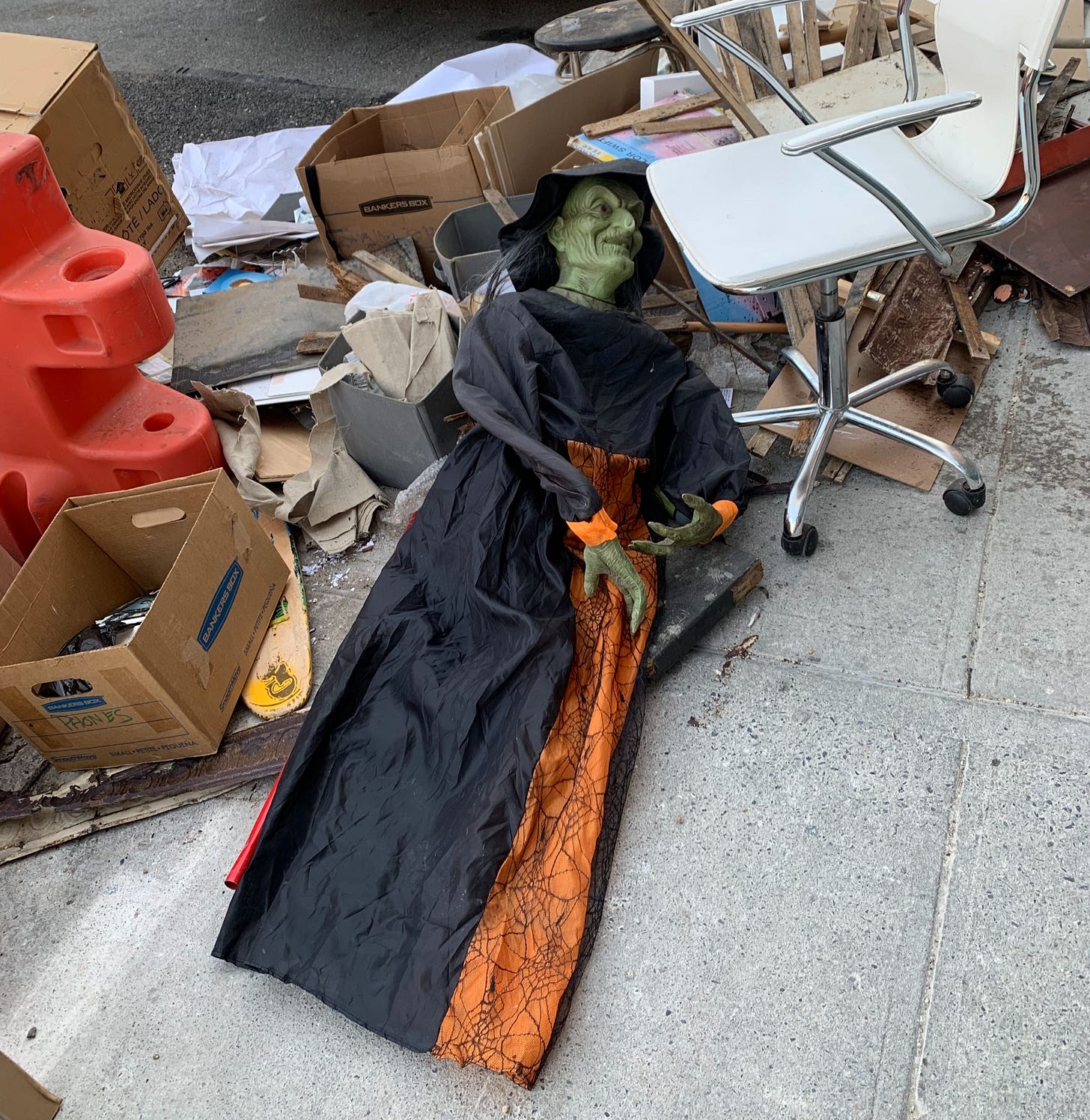Celebrating 25 Years of… What, Exactly?
2023 did not begin with the warm, comforting aura of promise that I’d hoped for - instead, the new year greeted me with a chilly blend of inconvenience, exhaustion, and sorrow that is only just beginning to dissipate. At some point I hope to contemplate and share the still-ongoing narratives that combined to create this circumstance, but it won’t be today. Instead, this newsletter will reach deep into the past - a quarter of a century, to be precise.
It was a bit of a shock to realize that January was the 25th anniversary of the founding of Piper McKenzie, the production company that Hope and I established to develop our theater work. When it started to sink in that this pivotal moment took place more than half my lifetime ago, I decided (after mopping up the tears) that it could be interesting to start revisiting the work we created together, along with our many friends and collaborators, starting at that time.
People who have only known me within the past 10 years or so might not fully grasp just how deeply my identity once depended on our avocation as theater artists. Pretty much every life decision we made was based on whether and how it could further our interest in producing live performance events of various stripes – to the extent that we’re still living with the ramifications of those decisions today, even though it’s been more than a decade since we last made such things a regular focus of our lives.
The era of Piper McKenzie lasted almost exactly 15 years – beginning in January 1998 and lasting until December 2013. During that time, I theorize that we produced approximately 35 shows as Piper McKenzie (which doesn’t count the dozens – possibly hundreds – of performances and festivals we produced as Associate Directors of The Brick from 2005-2012, which is a whole other series of overlapping threads, many of which will surface as part of this story). This amounted to thousands and thousands of hours spent writing, directing, designing, and acting - and even more emailing, scheduling, rescheduling, arguing, pleading, crying, shouting, drinking, dreaming, and denying that life had much else to offer.
This isn’t (yet) the story of how and why we left this world - you can read about that in this essay I wrote a few years back, which is still as keen and relevant to me now as it was then. No, this story is a kind of crypto-autobiography, a look at how I became the person I am today through the lens of the individual creations that Hope and I shepherded into being. For me, the goal is to rediscover some of the energy and wonder that prompted me to do these things in the first place, in the hopes of considering how I can tap back into it to inform what remains of my life. For you, who has been intrepid enough to read this far, my hope is that some of that energy and wonder will come out through these stories, and you’ll be entertained by the foibles, feats, and failures that characterized my youth. Maybe together we’ll be able to extract something worth saving.
The challenge of sharing a body of work in the theater is that there’s no way a reader can experience it as it happened. You can’t revisit it like a painting or rewatch it like a film - it’s gone, forever, except in the tangible fragments it’s left behind. In our case, there are scripts, photos, publicity materials, and stories that live on within people on both sides of the proscenium. It’s not a hell of a lot to go on, so these reminiscences will be spotty and subjective - like any other memory, I guess.
I’ll still be sharing new stuff in this newsletter, of course - I’m hard at work on the next installment of Congress of the Monsters (see below!), and I’m slowly beginning to prod with a tentative toe at other possible projects. Either way, thank you for valiantly reading to this point - as always, I’ll be curious to hear your thoughts about the stories contained herein.
Reeling in the years,
Jeff
THE HISTORY OF PIPER McKENZIE, PART 1: THE TINKLEPACK KIDS
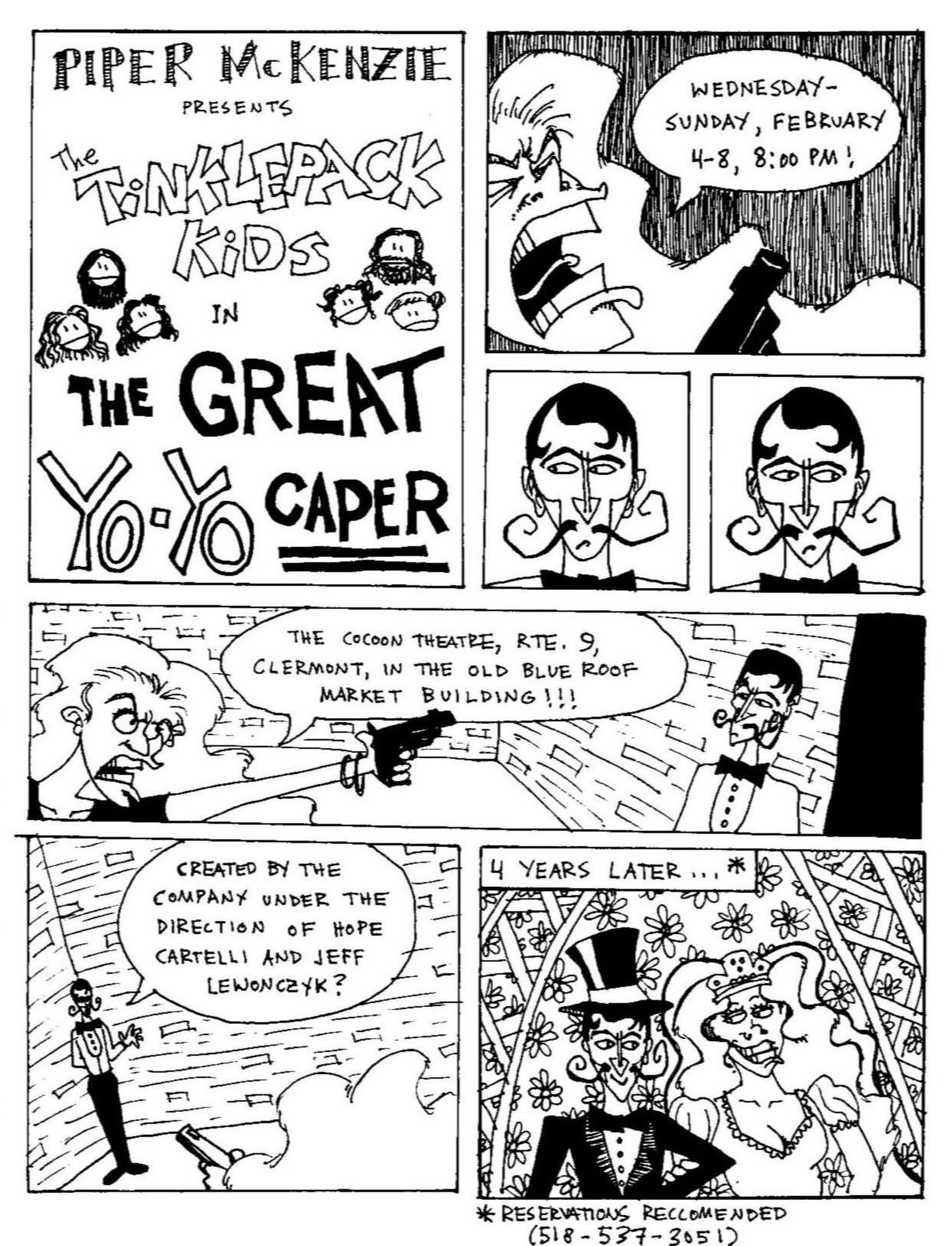
Our first show started out with nothing. It didn’t have a name, didn’t have a subject, didn’t have a single word or image to start from. All we had was an impulse to create, and a short window of conducive circumstances that allowed us to do so.
Hope and I met at Bard College, where we both majored in theater (or, in the parlance of the department at that time, Drama/Dance). Hope decided to save money on tuition by finishing up a semester early, and I followed suit because I didn’t want to get left behind. Our plan was to move directly to NYC and start producing our own shows, taking the theater world by storm with our undeniable and inexhaustible talent. We had already mounted some independent productions in school, a collaboration that predated our romantic involvement, and we had no interest in the whole headshots-and-auditions culture of mainstream theater. Grad school hadn’t even crossed our minds - we wanted to get out there and do stuff.
At this point, most of our friends were still in school for another semester or more, so we thought, hey - maybe for our first outing, we could just stick around and make something locally over winter break. During one of our aimless drives up and down the Hudson Valley, we had stumbled upon a small theater in a converted warehouse in Clermont, NY, 20 minutes north of campus. We reached out to the owners, a bohemian couple with three kids who lived on-site, and they agreed to let us use the space in January. Our first gig!
After three and a half years of traditional script-based productions, we were hungry to experiment. Our vision was to develop a show completely from scratch, but first we needed a starting point. No one familiar with my obsessions will be surprised that we found it in the comics. One of my favorite books of all time is Scott McCloud’s Understanding Comics, which is not only the best treatise on the art form but one of the greatest books about art, period - a guide to comics aesthetics in the form of a comic. This provided some formal guidance, but what about content? I can’t recall what nudged us in the direction of early newspaper comic strips - Little Nemo in Slumberland, Krazy Kat, Popeye, etc. - but the playful innocence of that burgeoning art form made a perfect fit for our own nascent ambitions. Procuring a stack of yellowing collections from local libraries gave us plenty of raw material to riff on.
A handful of classmates agreed to stick around for the break. Through school connections we managed to finagle a cheap stay in a sprawling farmhouse nearby, where most of the cast and crew eventually ended up living with us. During the first week, when we were still improvising around the source material, the theater owners told us they needed a title in order to send out a press release. At a complete loss, we all decided to just make something up, something with no relation to the play we were developing (not that we knew what that play was going to be). Someone thought it would be funny to have an absurdly long title-within-a-title: “[SOMETHING] presents [SOMETHING] in [The SOMETHING SOMETHING SOMETHING].” Affixed to the barn next to our farmhouse was a big old sign that said “Tinklepack,” which was the name of the business once run by the house’s owners (I believe you can still see it if you travel up Rte. 9 in Livingston). With that as our starting point, we just strung together a bunch of nonsense and landed on something suitably ridiculous: “Piper McKenzie Presents the Tinklepack Kids in the Great Yo-Yo Caper.”
The show itself was just like the process that engendered it - pure play. After a week of improvising and staging samples from our source material, we started to develop some core characters. At the center were Mammy and Pappy, an old couple who did nothing but sit in bed and squabble over whether Mammy would get up to prepare Pappy a glass of warm milk. Pappy, as played by Hope, was the clear breakout character - an irascible scamp whose single-minded devotion to his own comfort reached surreal heights. Her performance was infectious and all-encompassing - it was like she was possessed by the restless spirit of a long-dead codger. (Pappy appeared in multiple other projects over the years, but, with his scratchy southern accent and cracked diction, we worried that he could be interpreted as a condescending stereotype; I don’t think he’d fly today.) There were also young versions of Mammy and Pappy, whose courtship took a series of absurd turns; a hapless comic-book shop owner (played by me), whose business kept turning up in increasingly unlikely locations; and, best of all, a magical, wish-granting Abraham Lincoln, who was played at some point by every performer in the cast.
Images from some of our improvs in the space (check out the cool double exposure on the lower left!). N.B. The space hosted a glitter art exhibition during our rehearsal process.
(Also, I still have that shirt!)
After establishing the characters, I wrote out a script that set our best ideas to dialogue, which we had about a week to memorize. We each played about a dozen parts beyond our primary roles, and we staged a few wordless movement sketches that presaged our dance/pantomime work several years later. The show was structured as a series of blackout sketches inspired by the “gutter” that separates comic panels - we played with all sorts of ways to trick the audience into drawing connections between the scenes. This concept extended to our only props - a series of picture frames painted white, which we used to further refract the action. And when the audience came in, we gave them all tiny cardboard frames so they too could frame the action however they saw fit. In our final scene, we justified the title by revealing that the whole thing had been a collective dream experienced by the spunky Tinkepack Kids (who hadn’t previously appeared in the script) while under the thrall of Mean Mr. Mushroom’s Hypnotizing Yo-Yo. And scene!
There was a listing in the local newspaper! The eventual cast was only five of us.
Coming from a very academic theater program at cooler-than-school college, the opportunity to just let loose and muck about was a real rush - and the audience seemed to share it with us. In fairness. the novelty of the setting was a huge part of that. We opened the weekend before classes started, when students were returning to campus excited to shuffle off the winter blahs and have some fun before their workloads exploded. Most Bard kids, in my experience, at least, had fairly little intercourse with the surrounding community, making the very act of seeing an off-campus show an adventure. And the theater itself played an important role - the family’s kids ran around the lobby beforehand and sat in on every show. The building housed a cider press, so it always smelled of slightly fermented apples. And it was February in upstate New York, so the space was FREEZING. Despite blowing a noisy cannon-sized heater into the room for an hour before showtime, the heat vanished through the roof in about 30 seconds. So we offered the audience blankets as they walked in, which had the pleasant effect of bringing them into the same world as Mammy and Pappy. (You can read all about it in our sole review, in the Bard Observer, page three - one of only five results you get when you search “Tinkepack Kids.” Not much of an internet in 1998!)
It’s easy to romanticize such a twee experience, but it was a beginning in every sense - we were young, naive, optimistic, and privileged, and we were thrilled to share some of that energy with the world. There was amazingly little drama in the process - everyone working with us shared the same vibe, and I think we were all a bit shocked that it came out as well as it did, in all of its ramshackle plasticity. By having no expectations, we exceeded them all - a creative spirit I’ve spent more 25 years trying to recapture.
THE MONSTER THE MERRIER
I like to think that the first book of Congress of the Monsters was another important beginning for me - maybe it’s not perfect, but it’s gotten me rolling down a new path, which I’m still very excited about. (If you haven’t asked me for your copy yet, please do - I’ll be happy to put it in the mail for you!)
Work on the second installment is well underway. The story has been written and rewritten, and I’m about halfway through the illustrations. Here is a closer look at one of them, from sketch to “fuck it, I’m done.” (Disclaimer: These will never, ever, ever feel finished to me.)
MEDIA WHIRLWIND
And throughout it all, I’m still consuming media at a FAR brisker rate than I’m producing it. Here are some highlights.
BOOKS
Minn of the Mississippi, by Holling Clancy Holling
As a kid, I had a bias against nature books - I found them boring and irrelevant to my life of fantasy and television. As an adult, I’m glad that I finally have the perspective to enjoy what I was missing. Holling Clancy Holling (real name!) wrote a series of dense, weird, intricately illustrated kids’ books about the workings of the natural world - perhaps his most famous is Paddle-to-the-sea, which I read a few years ago (and which is the basis for a delightful Canadian short film that you should drop everything to watch). While that story is about how water moves through the world (using a hand-carved toy boat to embody the process), this one is about how animals move through water - in particular, how an ornery, three-legged snapping turtle named Minn traverses the entire Mississippi River, with all manner of adventures along the way. Bringing them to life are gorgeous full-page paintings and overstuffed margins filled with maps, sketches, and other informative renderings. Is some of it dated? Of course, it was published in 1951! But what would have bored me to tears 35 years later is magic to me 37 years after that.
Farmhouse, by Sophie Blackall
Another children’s book that I would not have had patience for as a child is Sophie Blackall’s latest. Farms were even worse than nature to me, because they were stuffy and dull and freighted with moral significance about hard work and crap. But Blackall is a genius at tapping the wonders of unassuming situations - her Hello, Lighthouse is one of my favorite picture books ever, and her latest is right up there. The backstory is that she bought an old farm in upstate New York and cobbled together the story - and its pictures - from the scraps left behind - the fabric, the newspapers, the memories of the inhabiting family’s descendents. The house had fallen into a state of disrepair and had to be razed, so this book is a melancholy tribute to lives that might otherwise have been forgotten, in all of their recalcitrant glory. The result is moving to contemplate, and gorgeous to look at.
The Caretaker, by Doon Arbus
Without going into detail, much of the drama I’ve been working through this year is based around houses and legacies and possessions and all that. So this novel - the first and (so far) only one written by the daughter of famed photographer Diane Arbus, who is a journalist and the manager of her mother’s formidable estate - hit the nail so squarely on the head that I’m still feeling reverberations a month later. It’s the prosy but slim tale of an unnamed drifter who lands a job overseeing an eccentric museum that houses the life’s work of a renowned collector and philosophizer of Stuff. After 25 years, the poor caretaker has understandably lost his mind, and his mind-numbing routines - and the dramatic steps he takes to finally disrupt them - force us to reckon with our own accumulations - physical, emotional, and mental. Sobering stuff for a pack rat like me.
Tex Avery: Les Dessins, by Patrick Brion
On a lighter note, here’s a peek behind the celluloid at the work of legendary screwball cartoon director Tex Avery. You’ve probably seen some of his work - from his early Looney Tunes shorts to the deadpan heroism of Droopy the Dog and, perhaps most iconically, the howling wolf who slams his fist on the table leers his eyes out of their sockets at the spectacle of a grown-up Red Riding Hood’s nightclub shenanigans - but it’s rare to see the man’s actual drawings. Unlike his contemporary Chuck Jones, Avery didn’t devote a lot of energy turning himself into a brand name, so this collection of sketches designed to guide his animators (published in France, natch) is a fascinating look at the images and gags that he found important enough to pencil out himself - cartoon mayhem distilled into a handful of crisp lines. Turns out he was really good at it!
The Free World: Art and Thought in the Cold War, by Louis Menand
I have a working theory that we’re most deeply influenced by the era our parents grew up in, because that’s where we inherit our fantasies and assumptions. This would explain why I’m so fascinated by the Cold War period - I love so much of the art and culture of that time, but I’m also curious as to WHY I love it so much. This weighty tome from New Yorker writer Menand doesn’t so much answer this question as give me new paths for inquiry. Rather than providing a linear history of the era’s thinkers and artists, Menand builds each chapter around a theme or medium, anchoring it with profiles of a few significant figures (think Pollock, Krasner, and Greenberg for the chapter on abstract expressionism, or Wright and Baldwin on the development of Black literature and letters). The result is an overstuffed panorama, which is either delightful or terrifying depending on where you stand - just like the era itself.
MOVIES
Everything Everywhere All at Once
Finally got to see this when it came back to theaters for the Oscar nominations. As someone who spends an inordinate amount of time wistfully tracking the exploits of my alternative selves, I loved it! Sure, it didn’t succeed in fully overcoming some cliches, but for the sheer scope of energy and imagination, it can’t be beat. More risk-taking mainstream movies like this, please!
TerrorVision
A delightfully schlocky mid-80s horror/sci-fi satire of media overconsumption, with a cast of Grade-A weirdos (including the sneeringly bug-eyed Gerrit Graham, who I got to meet a few times back in the day), wonderfully dumb special effects, and absolutely no fucks to give. The perfect blissed-out Saturday matinee (and available to watch on YouTube!)
The Phantom of the Paradise
How has this movie not always been a part of my life? We’ve been circling around it for years, but seeing Gerrit Graham in TerrorVision finally pushed us over the edge (he plays an unforgettable key role here). Brian DePalma’s 70s pastiche (encompassing Phantom of the Opera, Faust, Picture of Dorian Gray, and Paul Williams) has so much that I envy as an artist - delirious camp with the courage of its convictions, no-holds-barred visual weirdness, and yes, it’s a musical! This will forevermore be a standard in our home.
Gregory’s Girl
I love nothing more than a movie that entertains you while it keeps you guessing - what am I watching here? Did that really happen? Why would they do that???? That Bill Forsyth somehow managed to accomplish this feat in what could easily have been a straightforward 1980 teenage rom-com makes it that much more delirious. Gregory himself is such a thoroughly charming creation that it’s a delight to spend the running time of the movie as blissfully ignorant as he is. BONUS: Outrageously thick Scots accents!
Murder, He Says
Speaking of “Why would they do that????”, here is a 1945 slapstick comedy about Fred MacMurray getting stuck in an old dark house with a bunch of scary rednecks. Both intentionally and unintentionally funny and terrifying, it promises to elicit a slackjaw from even the most jaded comedy buff. There is nothing in here that should work, and I’m not sure how much of it does, but by the time the entire cast is stamped into bales of hay at the end, you’ll have taken one hell of a trip.
THE DAWNING OF A NEW CLAY
In a follow-up to last month’s featured video, I somehow lived 46.5 years without knowing that in the ‘70s Gumby creator Art Clokey made a deeply psychedelic short film about the evolution of consciousness. Turn the lights out, consume the mind-altering substance of your choice, and submit to the clay!
THIS MONTH'S EXTRA THING
Someone in my neighborhood threw out their witch.








